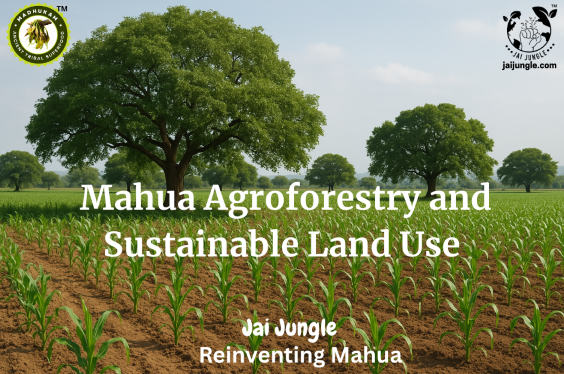Across the heartlands of central India, the Mahua tree (Madhuca longifolia) stands as both a forest guardian and a farmer’s friend.
While widely known for its sweet, fragrant flowers and oil-rich seeds, Mahua also plays an unseen yet powerful role in sustainable land use through agroforestry — the deliberate integration of trees into farming systems.
In traditional tribal landscapes, Mahua is rarely an outsider to agriculture. It grows naturally at the edges of fields, near wells, and even in the middle of crop plots — a quiet witness to centuries of coexistence between people, crops, and forests.
Mahua agroforestry is now gaining scientific recognition for what rural communities have long known: that the tree enriches the soil, supports biodiversity, and ensures an additional stream of livelihood without harming agricultural productivity (ICRAF 2023).
From the drought-prone plateaus of Chhattisgarh to the rolling farmlands of Madhya Pradesh and Jharkhand, farmers have practised a living form of sustainability — integrating Mahua into their fields not as a competing species, but as a life-sustaining partner.
1. Mahua in Farmlands: Traditional Integration and Ecological Logic
Long before “agroforestry” became a scientific term, farmers across central India were already practising it intuitively. When they cleared land for cultivation, they retained certain trees that offered food, fodder, or shade — Mahua being among the most cherished.
A mature Mahua tree can yield a significant quantity of flowers and seeds annually, depending on rainfall, soil health, and tree age (Orwa et al., 2009; World Agroforestry Database). These valuable by-products come with minimal maintenance and provide steady supplementary income.
Mahua’s deciduous nature makes it an ideal field companion. It sheds its leaves in late winter and flowers just before the monsoon. By the time farmers sow rain-fed crops such as millet, maize, or pulses in June–July, the Mahua canopy is light, allowing sunlight to reach the soil surface (ICRAF 2023).
The result is a complementary phenology — trees and crops occupying different ecological niches through the year. Mahua provides shade and soil cover during the harsh dry season and recedes just in time for crops to thrive.
In villages of Bastar and Jashpur, elders often describe Mahua as “the tree that rests when the farmer works, and works when the farmer rests.” This rhythmic partnership explains why it remains integral to tribal farming systems even today.
2. Agroforestry as a Dual-Income Model
In purely economic terms, Mahua agroforestry diversifies farm output. A single tree yields edible flowers for food and syrup production, seeds for oil extraction or biodiesel, and leaves for compost or fodder (FAO NTFP Database 2022).
For smallholders with a few hectares of land, maintaining Mahua trees within crop fields provides a valuable secondary harvest with virtually no additional input cost (NICE India 2022). This acts as a safety net when crops fail due to drought or pest outbreaks.
In tribal markets of Chhattisgarh, dried Mahua flowers and seeds are traded seasonally, providing reliable income. The oil seeds, in particular, serve dual markets — traditional uses and industrial processing for soap or biodiesel (NABARD 2021).
Thus, Mahua creates a steady income rhythm — crop income during the monsoon and Mahua-based income at the end of the dry season. This staggered harvest supports year-round cash flow for families that depend heavily on seasonal wages.
3. Soil, Water, and Microclimate Benefits
The Mahua tree contributes not just economically but ecologically. Its fallen leaves form a thick, nutrient-rich litter that decomposes into natural mulch, reducing water loss and improving soil fertility (Pharmacognosy Reviews 2019).
Mahua’s deep tap-root system penetrates far below the topsoil, breaking compact layers and improving aeration. Lateral roots stabilise the surface and enhance infiltration during heavy rains, recharging groundwater tables (Orwa et al., 2009).
Because Mahua’s water uptake peaks in the dry season, it rarely competes with shallow-rooted monsoon crops. Instead, the tree acts as a biological pump, drawing subsoil moisture and micronutrients upwards, subtly fertilising the upper layer used by crops.
Field observations in several central Indian districts have noted cooler ground temperatures and higher soil moisture under Mahua canopies compared with open plots. This moderation of the microclimate becomes invaluable as climate variability increases.
Farmers often call Mahua’s fallen leaves “green gold manure” — ploughing them back into the soil after collection season to improve organic content and moisture retention. Over time, this creates richer, darker, and more resilient soils suitable for rain-fed crops.
4. Livestock Integration: The Silvopastoral Connection
Mahua fits seamlessly into silvopastoral systems, where trees, crops, and livestock coexist. During summer, when most forage dries up, Mahua offers shade and supplementary fodder.
Goats and cattle relish the sweet fallen flowers; farmers in Jharkhand often describe how milk yield rises slightly during Mahua season due to this natural energy intake (field interviews 2021). Leaves can be selectively lopped and fed to goats in lean months, providing useful green fodder.
The manure from animals grazing beneath Mahua adds another nutrient loop — carbon and nitrogen cycling back into the soil. It is a classic closed-loop farming model, where every by-product supports another life form on the farm.
In mixed systems combining Mahua trees, seasonal crops, and livestock, farmers report higher overall land-equivalent ratios (LER), indicating greater productivity per hectare than single-use systems.
5. Environmental and Carbon Benefits
Every mature Mahua tree is a carbon reservoir. Studies suggest it can store large amounts of carbon in its biomass (IJ Plant and Environment 2019). Scaled across even small farmlands, Mahua contributes significantly to carbon sequestration while the land continues to yield food crops.
Beyond carbon, Mahua supports on-farm biodiversity. Its night-blooming flowers attract bats, bees, and moths — key pollinators that benefit adjacent crops. Birds and small mammals feed on fruits and insects that thrive in its canopy (Orwa et al., 2009).
When integrated systematically, Mahua acts as a keystone species linking agricultural and forest ecosystems. It bridges fragmented habitats, offering stepping stones for pollinators and ensuring genetic flow between forest patches.
Moreover, farms with tree cover experience lower soil erosion compared with open fields, as Mahua roots hold the soil and fallen leaves cushion raindrop impact (TERI Sustainability Paper 2020).
6. Community and Cultural Dimensions
Among tribal families, Mahua is not merely an economic asset; it is a social and cultural institution. Families mark life events — births, weddings, harvest festivals — with offerings of Mahua flowers or oil.
In villages of Surguja and Gumla, a Mahua tree is often referred to as “Annadata aur Amritadata” — the giver of food and nectar. Farmers protect it instinctively; even when timber is scarce, they rarely fell a healthy Mahua.
This cultural reverence has inadvertently created a community-based conservation model. Without formal policy enforcement, millions of privately owned Mahua trees survive across farmlands simply because they are sacred (Down to Earth 2021).
As rural youth migrate and agriculture changes, recognising this traditional stewardship becomes crucial. Programmes promoting Mahua agroforestry can build on existing cultural respect, framing conservation as continuity rather than a new imposition.
7. Case Examples from Central India
7.1 Boundary Plantations in Chhattisgarh
Many smallholders plant Mahua along field edges. These rows act as natural windbreaks, reducing soil loss during storms. The boundary trees also demarcate property lines and generate flower and seed income without occupying core cropping space (CG Agro Dept 2023).
7.2 Taungya-Style Intercropping
In areas of reforestation, farmers practise a version of the Taungya system — growing short-duration crops like pigeon pea or niger seed between young Mahua saplings. Until the trees mature, crops provide income, and later, Mahua becomes the dominant species.
7.3 Homegarden Integration in Odisha
In tribal Odisha, Mahua shares space with mango, jackfruit, and drumstick in homegardens. The partial shade allows cultivation of turmeric, yam, and medicinal herbs. These multilayered gardens exemplify climate-resilient farming, combining tree canopy, shrub layer, and root crops (Odisha Agroforestry Mission 2022).
8. Challenges and Research Gaps
Despite its promise, Mahua agroforestry faces practical constraints:
- Long gestation: trees grown from seed take 7–10 years to flower. Research into grafting or clonal propagation is essential (ICAR FRI 2020).
- Spatial competition: overly dense planting can hinder mechanised ploughing. Optimum spacing of 8–10 trees ha⁻¹ is advised (World Agroforestry Centre 2021).
- Fire risk: farmers sometimes burn fallen leaves to ease flower collection, risking soil sterilisation. Training on low-impact raking or mulching can mitigate this.
- Market volatility: Mahua flower prices fluctuate sharply between harvest and lean seasons. Building community-level storage and dehydration units can stabilise returns.
- Policy neglect: most state agroforestry missions still prioritise timber or fruit species. Inclusion of NTFP trees like Mahua under subsidy and insurance schemes would accelerate adoption.
Addressing these gaps could turn Mahua from a “co-existing tree” into a mainstream farm ally under climate-smart agriculture frameworks.
9. Policy and Institutional Support
The National Agroforestry Policy (2014) encouraged integrating trees into farmlands, but species choice often leaned toward eucalyptus or acacia. Incorporating indigenous, multi-benefit species like Mahua aligns better with India’s SDG commitments (MoEFCC 2022).
State governments such as Chhattisgarh and Jharkhand are already promoting Mahua under social forestry and NTFP-based livelihood missions. Programmes could be strengthened through:
- Sapling distribution drives linked with MNREGA for pit digging and initial care.
- Farmer producer companies (FPCs) for collective marketing and processing.
- Carbon credit aggregation recognising Mahua’s sequestration capacity.
- Research partnerships for product diversification and processing support.
Such multi-layered interventions bridge ecology, economy, and equity — the three pillars of sustainable land use.
10. The Tree of Plenty in Tomorrow’s Farms
Mahua agroforestry is more than a cultivation practice; it is a philosophy of coexistence. It demonstrates how food security, income diversity, and ecological resilience can grow from the same soil.
As climate uncertainties intensify, smallholders need systems that buffer risk without demanding heavy investment. Mahua provides exactly that — a self-sustaining tree that thrives on neglect, enriches land, and nourishes people.
By recognising and revitalising traditional Mahua-based farming, India can transform millions of scattered trees into a vast network of carbon sinks, biodiversity corridors, and rural income sources.
The Mahua tree, once relegated to folklore, now returns to the forefront of sustainable agriculture — a living symbol of how the forest and the farm can once again grow together.
References
- CG Agro Dept. (2023). Field notes on boundary plantation models in northern Chhattisgarh. Raipur: Department of Agriculture.
- Down to Earth (2021). “Mahua: The sacred livelihood tree of central India.” Retrieved from https://www.downtoearth.org.in/
- FAO (2022). Non-Timber Forest Products Database. Rome: FAO.
- ICAR-NRCAF (2018). Leaf litter nutrient composition of indigenous tree species. Jhansi: Indian Council of Agricultural Research.
- ICAR FRI (2020). Propagation trials for Madhuca longifolia. Dehradun: Forest Research Institute.
- ICRAF (2023). Agroforestry practices in dryland India. Nairobi: World Agroforestry Centre.
- IJ Plant and Environment (2019). “Carbon sequestration potential of Madhuca longifolia.” ResearchGate summary.
- MoEFCC (2022). India’s National Agroforestry Strategy 2022–27. New Delhi: Ministry of Environment, Forest and Climate Change.
- NABARD (2021). Market assessment of NTFP value chains in central India. Mumbai: NABARD.
- NICE India (2022). Community livelihoods assessment in Mahua-based economies. Bhubaneswar: NICE Organisation.
- Odisha Agroforestry Mission (2022). Homegarden agroforestry models in tribal districts. Bhubaneswar: Govt of Odisha.
- Orwa, C., Mutua, A., Kindt, R., Jamnadass, R., & Anthony, S. (2009). Agroforestry Database: Madhuca longifolia factsheet. World Agroforestry Centre.
- Pharmacognosy Reviews (2019). “Nutrient recycling from Mahua leaf litter.” Phcog Rev Journal.
- TERI (2020). Tree cover and soil erosion mitigation in drylands. New Delhi: The Energy and Resources Institute.

